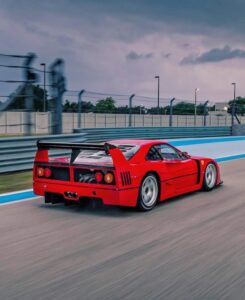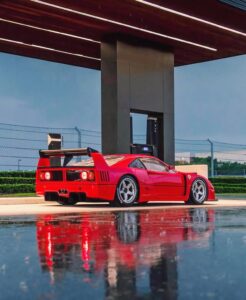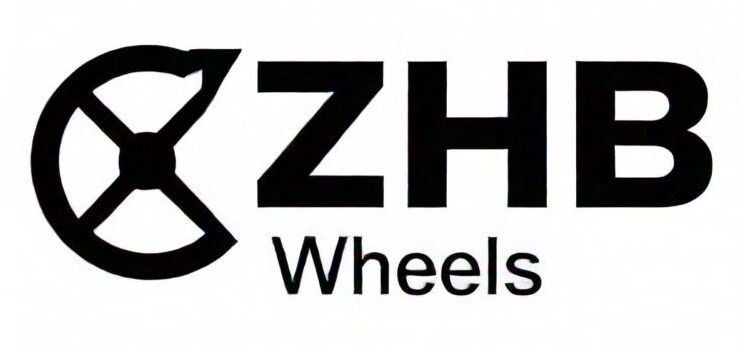Introduction:
The Ferrari F40 was manufactured between 1987 and 1992. From 1994 to 1996 the LM and GTE race car models were produced respectively. Enzo Ferrari personally approved the F40 the final Ferrari which was created to commemorate the companys 40th anniversary. At the time it was the most costly fastest and most potent vehicle available for purchase. Here are a few more Ferrari F40 facts. Pininfarina was the stylist and Nicola Materazzi was the engineer of the F40. This vehicle has rear-wheel drive and a mid-engine. A 2 point 9 L twin IHI turbocharged V8 engine with 471 horsepower powers the F40. A double wishbone suspension system is used on the F40. The F40 can be raised when necessary but its ground clearance is unusually low. $399150 was the suggested retail price for the F40 in 1987. F40 models can now fetch more than $1 million USD.
Here are some details about the Ferrari F40’s engine:

Type: 2.9 liter twin-turbocharged V8
Horsepower: 471 horsepower at 7,000 rpm
Torque: 426 lb-ft of torque at 4,000 rpm
Acceleration: 0–60 mph in 3.8 seconds
Top speed: 201 mph
Engine layout: Longitudinally-mounted, rear mid-engine, rear-wheel drive
Water-cooled blowers: Made by IHI.
The F40’s engine has twin overhead cams for each bank, four valves per cylinder, and twin turbos. The engine number is located at the engine/gearbox separating joint.
The F40 was the first production car to reach a top speed of 201 mph, which was a remarkable achievement in 1987.
Design and Features:

Body: Pininfarina designed the F40s body which is composed of aluminum carbon fiber and Kevlar. It was intended to be a robust and lightweight body. Ferraris recognizable Rosso Corsa color was used for all F40s when they were first produced.
Windows: To cut weight polycarbonate plastic was used to make the
F40s windows. The Lexan windows on the first fifty cars were sliding but later models had wind-down windows. Plexiglass was used to make the side and rear windows.
The F40s headlights were able to be flipped up. The purpose of the F40s forced induction engine was to dissipate
heat and be aerodynamic. It featured a big rear stabilizer a second undertray with diffusers behind the engine and a partial undertray. The F40s measurements were 44. 3% high by 77. 6% wide.
Hood: Two NACA-designed air intakes for the passenger compartment air conditioning and retractable headlights were features of the F40s hood.
The F40 was designed to be a road race car. Its tubular steel space-frame chassis and bonded Kevlar panels were part of its lightweight design.

Prices details:
Depending on its history options mileage and condition a Ferrari F40s price can change. The following information pertains to the cost of Ferrari F40s. Original list price: In current currency the Ferrari F40s original list price was over $1 million.

Average sale price: A Ferrari F40 typically sells for $2589355.
Highest sale ever: In 2022 a 1990 Ferrari F40 sold for $3965000 the highest amount ever recorded.
Lowest recorded sale: In 2020 a 1991 Ferrari F40 sold for $1386000 the lowest amount ever recorded.
1987 Ferrari F40: The average specs and good condition of an 1987 Ferrari F40 will set you back about $2400000. F40 LM: In 2019 the most expensive Ferrari F40 race car also referred to as the F40 LM cost €4842500 ($AU7). Ferrari F40s for sale include the following models. 1990 Ferrari F40: Sold at RM Sothebys in 2024 for $3360000. The body chassis engine and gearbox all match the vehicles numbers.

The 1992 Ferrari F40 is listed on duPont REGISTRY for $3499900.
Among the supercars remarkable features is the Ferrari F40. Top speed: 324 km/h (199 mph) was the top speed reported by Ferrari. Ferrari asserted acceleration. The time from 0 to 100 km/h (0 to 62 mph) was 4:01 seconds. Twin-turbocharged 2. 9L V8 engine producing 426 lb-ft of torque at 4000 rpm and 471 horsepower at 7000 rpm. The tires on the front and back have vented disc brakes. The tires are 17 inches. The tires are 17-inch 335 / 35 on the back and ch 245 / 45 on the front. The F40s performance was a consequence of its twin-turbocharged powertrain advanced aerodynamics and creative use of lightweight materials. The F40 also had the first body panels made of composite materials in a Ferrari production vehicle. The F40s design and performance have impacted many contemporary supercars.
From 1987 to 1992 F40s were manufactured.
Rare F40 LM: There were only 19 Ferrari F40 LMs produced. Enzo Ferraris approval: Enzo Ferrari personally approved the F40 as the final Ferrari vehicle.

Weight: The F40 weighed only about 2400 pounds thanks to its tubular chassis and Kevlar body panels.
Pop-up headlights: A recognizable design element of the F40 are its pop-up headlights which use halogen bulbs. Ferrari only made the F40 in Rosso Corsa at first.
Race car for road use: The F40 was a race car made specifically for use on roads. Absence of ABS: In order to reduce weight the F40 was built without ABS.
Air conditioning: Later air conditioning was installed to protect the cabin from the heat generated by the engine.
Why F40 Prodution Stoped :
The F40 model which was created to commemorate Ferraris 40th anniversary was eventually replaced by the F50 model which signaled a change in the companys design and technological focus. In essence the F40 was a limited-edition supercar that was meant to be purely performance-focused and not intended for long-term production.
The F40s production was halted because it reached the end of its planned production cycle. Important details regarding the F40s discontinuation. restricted production run.

Due to its limited production from 1987 to 1992 the F40 is now a highly sought-after classic vehicle. Spartan design. In contrast to more opulent Ferraris of the era the F40 was built to be incredibly lightweight performance-focused and spartan inside. Progress to F50.
The F50 which Ferrari developed after the F40 and included newer design elements and technologies represented a step up in the brands offerings.
Most Sales in Countries:
The United States received about 600 Ferrari F40s which were notably different from the European models Only ten Ferrari F40s were shipped to Australia. United Kingdom: In the UK there are 94 Ferrari F40s. Over the course of five years Ferrari produced 1311 F40s before ending production in 1992. The vehicles were limited to Rosso Corsa and left-hand drive. Nonetheless the Sultan of Brunei had roughly seven examples converted to right-hand drive. These are a few more noteworthy Ferrari F40-related events. A pre-production prototype of the F40 LM race car sold for €4842500 at RM Sothebys in February 2019. In October 2023 Collecting Cars broke the previous auction record in the UK by selling a 1991 Ferrari F40 for £1701000. At an online-only auction in the UK this was also the highest price ever paid for a car.


